Techno-Economic and Environmental Impact of Biomass Co-Firing with Carbon Capture and Storage in Indonesian Power Plants
Abstract
:1. Introduction
2. Materials and Methods
2.1. Study Case Description
2.2. Emission Regulation in Indonesia
2.3. Retrofitting Post-Combustion CCS Technology
2.3.1. Selective Catalytic Reduction (SCR)
2.3.2. Flue Gas Desulphurization (FGD)
2.3.3. Carbon Capture and Storage (CCS)
2.4. Integrated System Approach for Techno-Economic Assessment
2.5. Simulation Assumptions and Scenarios
3. Results
3.1. Effect of CCS on the Plant Energy Performance
3.2. Effect of CCS on the Plant Emission
3.3. Cost of Retrofitting CCS Technology
3.4. Effect of CCS on the Levelized Cost of Electricity
3.5. Cost of CO2 Avoided and Cost of CO2 Captured
- LCOEccs: LCOE PC CCS (USD/kWh);
- LCOEref: LCOE PC (USD/kWh);
- CO2 emissionref: emission factor PC (tCO2/kWh);
- CO2 emissionccs: emission factor PC CCS (tCO2/kWh).
- LCOEccs: LCOE PC CCS (USD/kWh);
- LCOEref: LCOE PC (USD/kWh);
- CO2 captured in CCS technology: difference of CO2 emission before and after;
- CO2 capturing (t CO2/kWh).
3.6. Fuel Cost Variability
3.7. Carbon Price Variability
4. Conclusions
Author Contributions
Funding
Institutional Review Board Statement
Informed Consent Statement
Data Availability Statement
Conflicts of Interest
Abbreviations
| CCS | Carbon capture and storage |
| CFPPs | Coal-fired power plants |
| CIF | Cost, insurance, and freight |
| ESP | Electrostatic precipitator |
| FGD | Flue gas desulphurization |
| GHG | Greenhouse gasses |
| HHV | High heating value |
| IECM | Integrated Environment Control Model |
| LCOE | Levelized cost of electricity |
| MEA | Monoethanolamine |
| O&M | Operation and maintenance |
| PC | Pulverized coal |
| PLN | Perusahaan Listrik Negara (State Electricity Company of Indonesia) |
| SCR | Selective catalytic reduction |
| WP | Wood pellet |
Appendix A
| Items | Unit | Typical Sub Bituminous Coal | Typical Wood Pellet |
|---|---|---|---|
| Carbon | % wt (AR) | 49.59 | 47.78 |
| Hydrogen | % wt (AR) | 3.79 | 6.07 |
| Oxygen | % wt (AR) | 15.49 | 39.39 |
| Chlorine | % wt (AR) | - | 0.10 |
| Sulfur | % wt (AR) | 0.08 | 0.07 |
| Nitrogen | % wt (AR) | 0.85 | 0.15 |
| Ash content | % wt (AR) | 2.04 | 1.08 |
| Total moisture | % wt (AR) | 28.16 | 5.46 |
| Caloric value (HHV) | kJ/kg (AR) | 20,553.00 | 18,773.61 |
| SiO2 | % wt (AR) | 38.56 | 3.56 |
| Al2O3 | % wt (AR) | 12.24 | 0.92 |
| Fe2O3 | % wt (AR) | 20.07 | 5.31 |
| CaO | % wt (AR) | 11.37 | 61.15 |
| MgO | % wt (AR) | 8.16 | 2.11 |
| K2O | % wt (AR) | 0.28 | 12.92 |
| Na2O | % wt (AR) | 0.56 | 0.82 |
| MnO2 | % wt (AR) | 0.18 | 0.37 |
| TiO2 | % wt (AR) | 1.13 | 0.34 |
| P2O5 | % wt (AR) | 0.51 | 0.57 |
| SO3 | % wt (AR) | 6.36 | 9.86 |
| No. | Unit | PC (WP 0%) | PC (WP 5%) | PC (WP 10%) | PC (WP 20%) | PC CCS (WP 0%) | PC CCS (WP 5%) | PC CCS (WP 10%) | PC CCS (WP 20%) |
|---|---|---|---|---|---|---|---|---|---|
| PC Base plant | USD/kWh | 0.0472 | 0.0486 | 0.0500 | 0.0528 | 0.0434 | 0.0445 | 0.0462 | 0.0492 |
| land | USD/kWh | 0.000024 | 0.000024 | 0.000024 | 0.000024 | 0.000030 | 0.000030 | 0.000030 | 0.000031 |
| TSP control (ESP) | USD/kWh | 0.0015 | 0.0015 | 0.0015 | 0.0015 | 0.0029 | 0.0029 | 0.0029 | 0.0030 |
| NOx control | USD/kWh | - | - | - | - | 0.0040 | 0.0040 | 0.0041 | 0.0042 |
| SO2 control | USD/kWh | - | - | - | - | 0.0103 | 0.0109 | 0.0111 | 0.0118 |
| CO2 capture, transportation, storage | USD/kWh | - | - | - | - | 0.0682 | 0.0701 | 0.0710 | 0.0731 |
| LCOE total | USD/kWh | 0.0488 | 0.0501 | 0.0515 | 0.0544 | 0.1287 | 0.1325 | 0.1353 | 0.1414 |
| No. | Unit | PC (WP 0%) | PC (WP 5%) | PC (WP 10%) | PC (WP 20%) |
|---|---|---|---|---|---|
| Fixed O&M (base plant) | USD/kWh | 0.0026 | 0.0026 | 0.0026 | 0.0026 |
| Variable O&M (base plant) | USD/kWh | 0.0005 | 0.0004 | 0.0005 | 0.0004 |
| Fuel cost (base plant) | USD/kWh | 0.0321 | 0.0335 | 0.0349 | 0.0377 |
| Annual capital cost (base plant) | USD/kWh | 0.0136 | 0.0136 | 0.0136 | 0.0136 |
| Fixed O&M (CCS) | USD/kWh | - | - | - | - |
| Variable O&M (CCS) | USD/kWh | - | - | - | - |
| Annual capital cost (CCS) | USD/kWh | - | - | - | - |
| LCOE total | USD/kWh | 0.0488 | 0.0501 | 0.0515 | 0.0544 |
| No. | Unit | PC CCS (WP 0%) | PC CCS (WP 5%) | PC CCS (WP 10%) | PC CCS (WP 20%) |
|---|---|---|---|---|---|
| Fixed O&M (base plant) | USD/kWh | 0.0039 | 0.0039 | 0.0039 | 0.0039 |
| Variable O&M (base plant) | USD/kWh | 0.0006 | 0.0006 | 0.0006 | 0.0007 |
| Fuel cost (base plant) | USD/kWh | 0.0204 | 0.0214 | 0.0231 | 0.0259 |
| Annual capital cost (base plant) | USD/kWh | 0.0203 | 0.0204 | 0.0204 | 0.0206 |
| Fixed O&M (CCS) | USD/kWh | 0.0047 | 0.0049 | 0.0049 | 0.0050 |
| Variable O&M (CCS) | USD/kWh | 0.0630 | 0.0649 | 0.0659 | 0.0687 |
| Annual capital cost (CCS) | USD/kWh | 0.0157 | 0.0164 | 0.0165 | 0.0167 |
| LCOE total | USD/kWh | 0.1287 | 0.1325 | 0.1353 | 0.1414 |
References
- United Nations. Causes and Effects of Climate Change. Available online: https://www.un.org/en/climatechange/science/causes-effects-climate-change (accessed on 1 April 2023).
- EPA. Global Greenhouse Gas Emissions Data. Available online: https://www.epa.gov/ghgemissions/global-greenhouse-gas-emissions-data (accessed on 12 May 2023).
- National Academy of Sciences. Climate Change: Evidence and Causes: Update 2020; The National Academies Press: Washington, DC, USA, 2020; ISBN 978-0-309-67502-4. [Google Scholar]
- Ebi, K.L.; Vanos, J.; Baldwin, J.W.; Bell, J.E.; Hondula, D.M.; Errett, N.A.; Hayes, K.; Reid, C.E.; Saha, S.; Spector, J.; et al. Extreme Weather and Climate Change: Population Health and Health System Implications. Annu. Rev. Public Health 2020, 42, 293–315. [Google Scholar] [CrossRef] [PubMed]
- Abbass, K.; Qasim, M.Z.; Song, H.; Murshed, M.; Mahmood, H.; Younis, I. A Review of the Global Climate Change Impacts, Adaptation, and Sustainable Mitigation Measures. Environ. Sci. Pollut. Res. 2022, 29, 42539–42559. [Google Scholar] [CrossRef] [PubMed]
- Malhi, Y.; Franklin, J.; Seddon, N.; Solan, M.; Turner, M.G.; Field, C.B.; Knowlton, N. Climate Change and Ecosystems: Threats, Opportunities and Solutions. Philos. Trans. R. Soc. B Biol. Sci. 2020, 375, 104. [Google Scholar] [CrossRef]
- IPCC. Summary for Policymakers Sixth Assessment Report (WG3); IPCC: Geneva, Switzerland, 2022; ISBN 9781107415416. [Google Scholar]
- International Energy Agency. CO2 Emissions in 2022; International Energy Agency: Paris, France, 2023. [Google Scholar]
- Ritchie, H.; Rosado, P.; Roser, M. CO2 and Greenhouse Gas Emissions. Our World Data. 2020. Available online: https://ourworldindata.org/co2-and-greenhouse-gas-emissions (accessed on 19 February 2024).
- IEA. CO2 Emissions from Electricity and Heat Production by Fuel, and Share by Fuel, 2000–2021. Available online: https://www.iea.org/data-and-statistics/charts/co2-emissions-from-electricity-and-heat-production-by-fuel-and-share-by-fuel-2000-2021 (accessed on 12 May 2023).
- Enerdata Electricity Production. Available online: https://yearbook.enerdata.net/electricity/world-electricity-production-statistics.html (accessed on 9 August 2023).
- Ritchie, H.; Rosado, P.; Roser, M. Electricity Mix. Available online: https://ourworldindata.org/electricity-mix (accessed on 11 August 2023).
- British Petroleum. Statistical Review of World Energy 2022; British Petroleum: London, UK, 2022. [Google Scholar]
- CEC. Electricity Generation in China from 2011 to 2021, by Source. Available online: https://www-statista-com.ezproxy.ugm.ac.id/statistics/302233/china-power-generation-by-source/ (accessed on 9 October 2023).
- BP. Statistical Review of World Energy & Ember Electricity Production by Source, Indonesia. Available online: https://ourworldindata.org/grapher/electricity-prod-source-stacked?country=~IDN (accessed on 7 October 2023).
- European Commission. European Bioenergy Netwrok: Biomass Co-Firing, an Efficient Way to Reduce Greenhouse Gas Emissions. Available online: https://energy.ec.europa.eu/system/files/2015-02/2003_cofiring_eu_bionet_0.pdf (accessed on 3 January 2024).
- Al-mansour, F.; Zuwala, J. An Evaluation of Biomass Co-Firing in Europe. Biomass Bioenergy 2010, 34, 620–629. [Google Scholar] [CrossRef]
- Primadita, D.S.; Kumara, I.N.S.; Ariastina, W.G. A Review on Biomass for Electricity Generation in Indonesia. J. Electr. Electron. Inform. 2020, 4, 1. [Google Scholar] [CrossRef]
- Triani, M.; Tanbar, F.; Cahyo, N.; Sitanggang, R.; Sumiarsa, D.; Lara Utama, G. The Potential Implementation of Biomass Co-Firing with Coal in Power Plant on Emission and Economic Aspects: A Review. EKSAKTA J. Sci. Data Anal. 2022, 3, 83–94. [Google Scholar] [CrossRef]
- Van Loo, S.; Koppejan, J. The Handbook of Biomass Combustion & Co-Firing; Earthscan: London, UK, 2008; ISBN 9783131450715. [Google Scholar]
- Dzikuć, M.; Łasiński, K. Technical and Economic Aspects of Biomass Co-Firing in Coal-Fired Boilers. Int. J. Appl. Mech. Eng. 2014, 19, 849–855. [Google Scholar] [CrossRef]
- Roni, M.S.; Chowdhury, S.; Mamun, S.; Marufuzzaman, M.; Lein, W.; Johnson, S. Biomass Co-Firing Technology with Policies, Challenges, and Opportunities: A Global Review. Renew. Sustain. Energy Rev. 2017, 78, 1089–1101. [Google Scholar] [CrossRef]
- Arifin, Z.; Insani, V.F.S.; Idris, M.; Hadiyati, K.R.; Anugia, Z.; Irianto, D. Techno-Economic Analysis of Co-Firing for Pulverized Coal Boilers Power Plant in Indonesia. Int. J. Renew. Energy Dev. 2023, 12, 261–269. [Google Scholar] [CrossRef]
- Cahyo, N.; Triani, M.; Sitanggang, R.; Supriyanto, E.; PLN Puslitbang, P.; PLN Jl Duren Tiga Raya No, P.; Selatan, J. Simulasi Karakteristik Co-Firing Sekam Padi Pada PLTU Batubara Pulverized Coal Kapasitas 400 MWe. Rotasi 2022, 24, 43–53. [Google Scholar] [CrossRef]
- Cahyo, N.; Alif, H.H.; Aditya, I.A.; Saksono, H.D. Co-Firing Characteristics of Wood Pellets on Pulverized Coal Power Plant. In Proceedings of the IOP Conference Series: Materials Science and Engineering, Sanya, China, 12–14 November 2021; Volume 1098, p. 062088. [Google Scholar]
- Cahyo, N.; Hapsari, T.W.D.; Aprilana, A. Co-Firing Sawdust with Coal on Indonesia’s Coal-Fired Power Plant: Status and Opportunities. In Proceedings of the 2022 International Conference on Technology and Policy in Energy & Electric Power (ICT-PEP 2022), Jakarta, Indonesia, 18–20 October 2022; IEEE: Piscataway, NJ, USA, 2022; pp. 214–219. [Google Scholar] [CrossRef]
- Cahyo, N.; Alif, H.H.; Saksono, H.D.; Paryanto, P. Performance and Emission Characteristic of Co-Firing of Wood Pellets with Sub-Bituminous Coal in a 330 MWe Pulverized Coal Boiler. In Proceeding of the 2nd Internation Conference on Technology and Policy in Energy and Electric Power (ICT-PEP 2020), Bandung, Indonesia, 23–24 September 2020; pp. 44–47. [Google Scholar] [CrossRef]
- Bui, M.; Adjiman, C.S.; Anthony, E.J.; Boston, A.; Brown, S.; Fennell, P.S.; Fuss, S.; Galindo, A.; Hackett, L.A.; Hallett, J.P.; et al. Carbon Capture and Storage (CCS): The Way Forward. Energy Environ. Sci. 2018, 11, 1062–1176. [Google Scholar] [CrossRef]
- Page, B.; Turan, G.; Zapantis, A.; Beck, L.; Consoli, C.; Havercroft, I.; Liu, H.; Loria, P.; Schneider, A.; Tamme, E.; et al. Global Status of CCS 2019; Global CSS Institute: Melbourne, Australia, 2019. [Google Scholar]
- Page, B.; Turan, G.; Zapantis, A.; Burrows, J.; Consoli, C.; Erikson, J.; Havercroft, I.; Kearns, D.; Liu, H.; Dominic, R.; et al. Global Status of CCS 2020; Global CSS Institute: Melbourne, Australia, 2020. [Google Scholar]
- Turan, G.; Zapantis, A.; Kearns, D.; Tamme, E.; Staib, C.; Zhang, T.; Burrows, J.; Gillespie, A.; Havercroft, I.; Rassool, D.; et al. Global Status of CCS 2021; Global CSS Institute: Melbourne, Australia, 2021. [Google Scholar]
- Hong, W.Y. Carbon Capture Science & Technology, A Techno-Economic Review on Carbon Capture, Utilisation and Storage Systems for Achieving a Net-Zero CO2 Emissions Future. Carbon Capture Sci. Technol. 2022, 3, 100044. [Google Scholar] [CrossRef]
- Dubey, A.; Arora, A. Advancements in Carbon Capture Technologies: A Review. J. Clean. Prod. 2022, 373, 133932. [Google Scholar] [CrossRef]
- Rubin, E.S.; Mantripragada, H.; Marks, A.; Versteeg, P.; Kitchin, J. The Outlook for Improved Carbon Capture Technology. Prog. Energy Combust. Sci. 2012, 38, 630–671. [Google Scholar] [CrossRef]
- Wilberforce, T.; Olabi, A.G.; Taha, E.; Elsaid, K.; Ali, M. Science of the Total Environment Progress in Carbon Capture Technologies. Sci. Total Environ. 2021, 761, 143203. [Google Scholar] [CrossRef] [PubMed]
- Knudsen, J.N.; Jensen, J.N.; Vilhelmsen, P.; Biede, O. Experience with CO2 Capture from Coal Flue Gas in Pilot-Scale: Testing of Different Amine Solvents. Energy Procedia 2009, 1, 783–790. [Google Scholar] [CrossRef]
- Hasan, S.; Abbas, A.J.; Nasr, G.G. Improving the Carbon Capture Efficiency for Gas Power Plants through Amine-Based Absorbents. Sustainability 2021, 13, 72. [Google Scholar] [CrossRef]
- Giannaris, S.; Janowczyk, D.; Ruffini, J.; Hill, K.; Jacobs, B.; Bruce, C.; Feng, Y.; Srisang, W. SaskPower’s Boundary Dam Unit 3 Carbon Capture Facility-The Journey to Achieving Reliability. In Proceedings of the 15th International Conference on Greenhouse Gas Control Technologies, Abu Dhabi, United Arab Emirates, 15–18 March 2021. [Google Scholar]
- Petra Nova Parish Holding LLC. Final Scientific/Technical Report Petra Nova; Petra Nova Parish Holding: Thompsons, TX, USA, 2020. [Google Scholar]
- Mantripragada, H.C.; Zhai, H.; Rubin, E.S. International Journal of Greenhouse Gas Control Boundary Dam or Petra Nova–Which Is a Better Model for CCS Energy Supply? Int. J. Greenh. Gas Control 2019, 82, 59–68. [Google Scholar] [CrossRef]
- Al-Qayim, K.; Nimmo, W.; Pourkashanian, M. Comparative Techno-Economic Assessment of Biomass and Coal with CCS Technologies in a Pulverized Combustion Power Plant in the United Kingdom. Int. J. Greenh. Gas Control 2015, 43, 82–92. [Google Scholar] [CrossRef]
- Domenichini, R.; Gasparini, F.; Cotone, P.; Santos, S. Techno-Economic Evaluation of Biomass Fired or Co-Fired Power Plants with Post Combustion CO2 Capture. Energy Procedia 2011, 4, 1851–1860. [Google Scholar] [CrossRef]
- Khorshidi, Z.; Ho, M.T.; Wiley, D.E. Techno-Economic Study of Biomass Co-Firing with and without CO2 Capture in an Australian Black Coal-Fired Power Plant. Energy Procedia 2013, 37, 6035–6042. [Google Scholar] [CrossRef]
- The World Bank. Carbon Capture Storage (CCS) for Coal-Fired Power Plants in Indonesia; The World Bank: Washington, DC, USA, 2015. [Google Scholar]
- Susantoro, T.M.; Susantoro, T.M.; Wikantika, K.; Sunarjanto, D.; Wahyudi, P.; Kepies, S. CCUS-EOR Optimization to Achieve Zero Emission Program Targets in Northwest Java Basin CCUS-EOR Optimization to Achieve Zero Emission Program Targets in Northwest Java Basin. Evergreen 2023, 10, 1809–1818. [Google Scholar] [CrossRef]
- ASTM D 388-99; Standard Classification of Coals by Rank. ASTM Internation: West Conshocken, PA, USA, 2017; Volume 5.
- Google. Google Maps. Available online: https://www.google.com/maps/d/edit?mid=1uxU1Ws87bs9O9tr3_n5pNkz_As2RgmQ&ll=-0.6570145835678902%2C104.49307809681076&z=5 (accessed on 1 January 2024).
- ESRI. Oil and Gas Features-Indonesia. Available online: https://www.arcgis.com/apps/mapviewer/index.html?webmap=e27dedd8e9df46a89ca0e9e7cc3e201b (accessed on 8 February 2024).
- Menteri Lingkungan Hidup dan Kehutanan Republik Indonesia. Peraturan Menteri Lingkungan Hidup dan Kehutanan Republik Indonesia Nomor P.15/MENLHK/SETJEN/KUM.1/4/2019, Tentang Baku Mutu Emisi Pembangkit Listrik Tenaga Termal; Minister of Environment and Forestry of the Republic of Indonesia: Jakarta, Indonesia, 2019; pp. 1–56. [Google Scholar]
- IECM; Carnegie Mellon University; NETL. Pulverized Coal-Fired Power Plants and Air Pollution Controls; European Institute for Multidisciplinary Research: Brussels, Belgium, 2019. [Google Scholar]
- Bhown, A.S.; Freeman, B.C. Analysis and Status of Post-Combustion Carbon Dioxide Capture Technologies. Environ. Sci. Technol. 2011, 45, 8624–8632. [Google Scholar] [CrossRef] [PubMed]
- Hedriana, O. Assessment of CO2-EOR and Storage Capacity in South Sumatera and West Java Basins. Energy Procedia 2017, 114, 4666–4678. [Google Scholar] [CrossRef]
- Marbun, B.T.H.; Sinaga, S.Z.; Lie, H.S.; Promediaz, A.; Bandung, I.T. Northwest Java and East Natuna Field: Perspective To Apply Carbon Capture and Storage (CCS) in Indonesia. In Proceedings of the Carbon Management Technology Conference, Orlando, FL, USA, 7–9 February 2012. [Google Scholar] [CrossRef]
- IECM. Integrated Environmental Control Model (IECM) Version 11.5 (Carnegie Mellon University). Available online: https://www.cmu.edu/epp/iecm/index.html (accessed on 11 January 2024).
- IECM; Carnegie Mellon University; NETL. IECM Technical Documentation: Amine-Based Post Combustion CO2 Capture; European Institute for Multidisciplinary Research: Brussels, Belgium, 2019.
- Yang, B.; Wei, Y.M.; Hou, Y.; Li, H.; Wang, P. Life Cycle Environmental Impact Assessment of Fuel Mix-Based Biomass Co-Firing Plants with CO2 Capture and Storage. Appl. Energy 2019, 252, 113483. [Google Scholar] [CrossRef]
- Emenike, O.; Michailos, S.; Finney, K.N.; Hughes, K.J.; Ingham, D. Initial Techno-Economic Screening of BECCS Technologies in Power Generation for a Range of Biomass Feedstock. Sustain. Energy Technol. Assess. 2020, 40, 100743. [Google Scholar] [CrossRef]
- Zhai, H.; Mantripragada, H. A Technical and Economic Assessment of Advanced Carbon Capture Technologies. In Proceedings of the 14th International Conference on Greenhouse Gas Control Technologies, Melbourne, Australia, 21–25 October 2019. [Google Scholar]
- Zhao, L.; Xiao, Y.; Sims, K.; Wang, B.; Xu, X. Technical, Environmental, and Economic Assessment of Deploying Advanced Coal Power Technologies in the Chinese Context. Energy Policy 2008, 36, 2709–2718. [Google Scholar] [CrossRef]
- Wu, N.; Parsons, J.E.; Polenske, K.R. The Impact of Future Carbon Prices on CCS Investment for Power Generation in China. Energy Policy 2013, 54, 160–172. [Google Scholar] [CrossRef]
- Hu, B.; Zhai, H. The Cost of Carbon Capture and Storage for Coal-Fired Power Plants in China. Int. J. Greenh. Gas Control 2017, 65, 23–31. [Google Scholar] [CrossRef]
- Trading Economics Indonesia Interest Rate. Available online: https://tradingeconomics.com/indonesia/interest-rate (accessed on 4 September 2023).
- Bank of Indonesia. BI 7-Day (Reverse) Repo Rate. Available online: https://www.bi.go.id/id/statistik/indikator/bi-rate.aspx (accessed on 4 September 2023).
- Menteri Energi dan Sumber Daya Mineral Republik Indonesia. Peraturan Menteri Energi dan Sumber Daya Mineral Republik Indonesia Nomor, 139.K.HK.02/MEM.B/2021; Minister of Environment and Forestry of the Republic of Indonesia: Jakarta, Indonesia, 2021. [Google Scholar]
- Simangunsong, B.C.H.; Sitanggang, V.J.; Manurung, E.G.T.; Rahmadi, A.; Moore, G.A.; Aye, L.; Tambunan, A.H. Forest Policy and Economics Potential Forest Biomass Resource as Feedstock for Bioenergy and Its Economic Value in Indonesia. For. Policy Econ. 2017, 81, 10–17. [Google Scholar] [CrossRef]
- Charles, B.; Imangunsong, H.S.; Samuel, G.; Ilalahi, J.S.; Dida, M.; Aulana, G.M.; Itanggang, V.J.S.; Ganda, E.; Anurung, T.M.; Lias, E.E.; et al. Economic Value of Wood Processing Mill Residues as Feedstock for Bioenergy in Indonesia. J. Jpn. Inst. Energy 2019, 98, 110–114. [Google Scholar]
- PwC. Indonesian Pocket Tax Book; PwC: Jakarta, Indonesia, 2023. [Google Scholar]
- Gubernur Jawa Barat Republik Indonesia. Keputusan Gubernur Jawa Barat No. 561/Kep.732-Kesra/2021; Governor of West Java, Republic of Indonesia: Jakarta, Indonesia, 2022. [Google Scholar]
- Intratec Solutions LLC. Ammonia Price, Current, and Forecast. Available online: https://www.intratec.us/chemical-markets/ammonia-price (accessed on 31 January 2024).
- Intratec Solutions LLC. Monoethanolamine Price, Current and Historical. Available online: https://www.intratec.us/chemical-markets/monoethanolamine-price (accessed on 31 January 2024).
- Smith, E.; Morris, J.; Kheshgi, H.; Teletzke, G.; Herzog, H.; Paltsev, S. The Cost of CO2 Transport and Storage in Global Integrated Assessment Modeling. Int. J. Greenh. Gas Control 2021, 109, 103367. [Google Scholar] [CrossRef]
- Rubin, E.S. International Journal of Greenhouse Gas Control Understanding the Pitfalls of CCS Cost Estimates. Int. J. Greenh. Gas Control 2012, 10, 181–190. [Google Scholar] [CrossRef]
- PT PLN (Persero). Statistik PLN 2022; PT Perusahaan Listrik Negara: Jakarta, Indonesia, 2023. [Google Scholar]
- Statista. Cost of Electricity Generation from Coal in Indonesia from 2013 to 2022. Available online: https://www-statista-com.ezproxy.ugm.ac.id/statistics/1092956/indonesia-cost-of-electricity-generation-from-coal-2018/ (accessed on 30 January 2024).
- International Energy Agency; Nuclear Energy Agency. Projected Costs of Generating Electricity 2015 Edition; International Energy Agency: Paris, France, 2015. [Google Scholar]
- Minister Energy and Mineral Resources Republic of Indonesia; PT. PLN (Persero). Data Collection Survey on Power Sector in Indonesia; PT Perusahaan Listrik Negara: Jakarta, Indonesia, 2022. [Google Scholar]
- Shao, Y.; He, X.; Yang, C.; Zhu, Y.; Liu, C.; Shao, L.; Ni, Y. Techno-Economic Evaluation of CO2 Capture and Storage Retrofit in Decarbonizing Different Thermal Power Plants: A Case Study in China. Appl. Therm. Eng. 2024, 242, 122380. [Google Scholar] [CrossRef]
- The World Bank. State and Trends of Carbon Pricing 2022; The World Bank: Washington, DC, USA, 2022; ISBN 9781464818950. [Google Scholar]
- Statista. Carbon Tax Rates Worldwide as of 31 March 2023. Available online: https://www-statista-com.ezproxy.ugm.ac.id/statistics/483590/prices-of-implemented-carbon-pricing-instruments-worldwide-by-select-country/ (accessed on 5 February 2024).
- Kementerian Energi dan Sumber Daya Mineral Republik Indonesia. Peraturan Menteri ESDM, No. 16 Tahun 2022 Tata Cara Penyelenggaraan Nilai Ekonomi Karbon Subsektor Pembangkit Tenaga Listrik; Ministry of Energy and Mineral Resources of the Republic of Indonesia: Jakarta, Indonesia, 2022.
- Kementerian Energi dan Sumber Daya Mineral Republik Indonesia. Keputusan Menteri Energi dan Sumber Daya Mineral Republik Indonesia, No. 169.K/HK.02/MEM.M/2021; Ministry of Energy and Mineral Resources of the Republic of Indonesia: Jakarta, Indonesia, 2021.
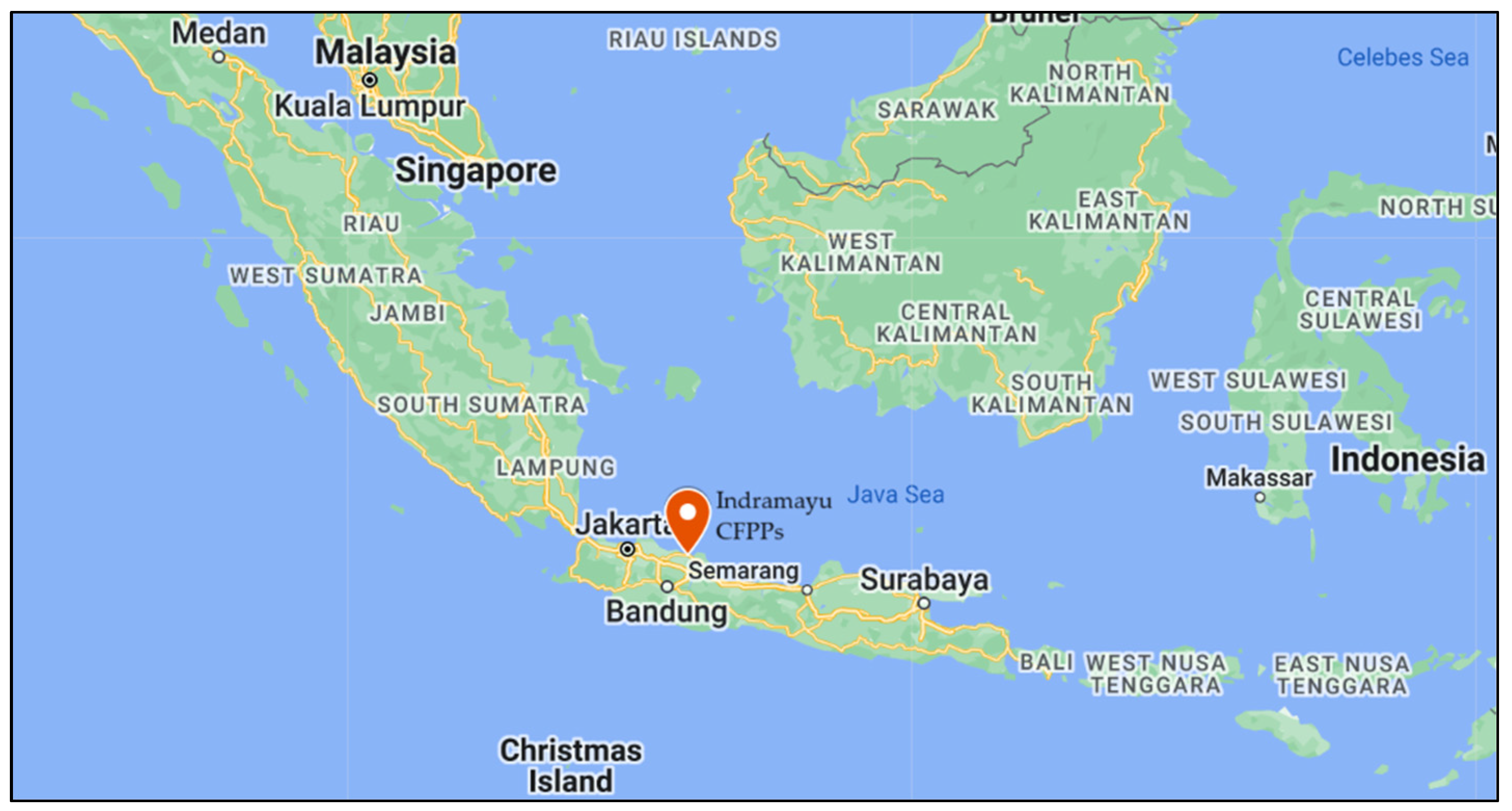
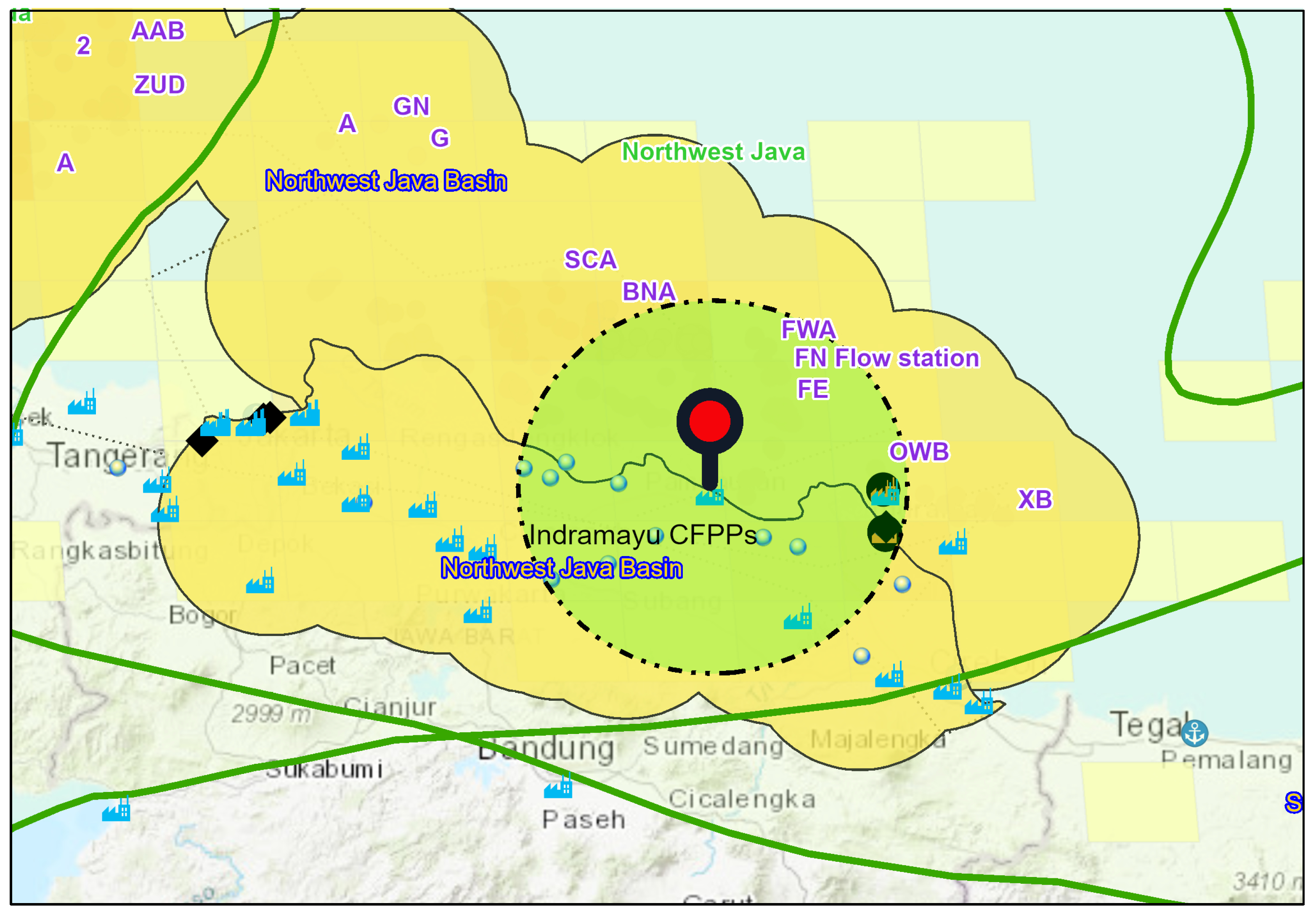

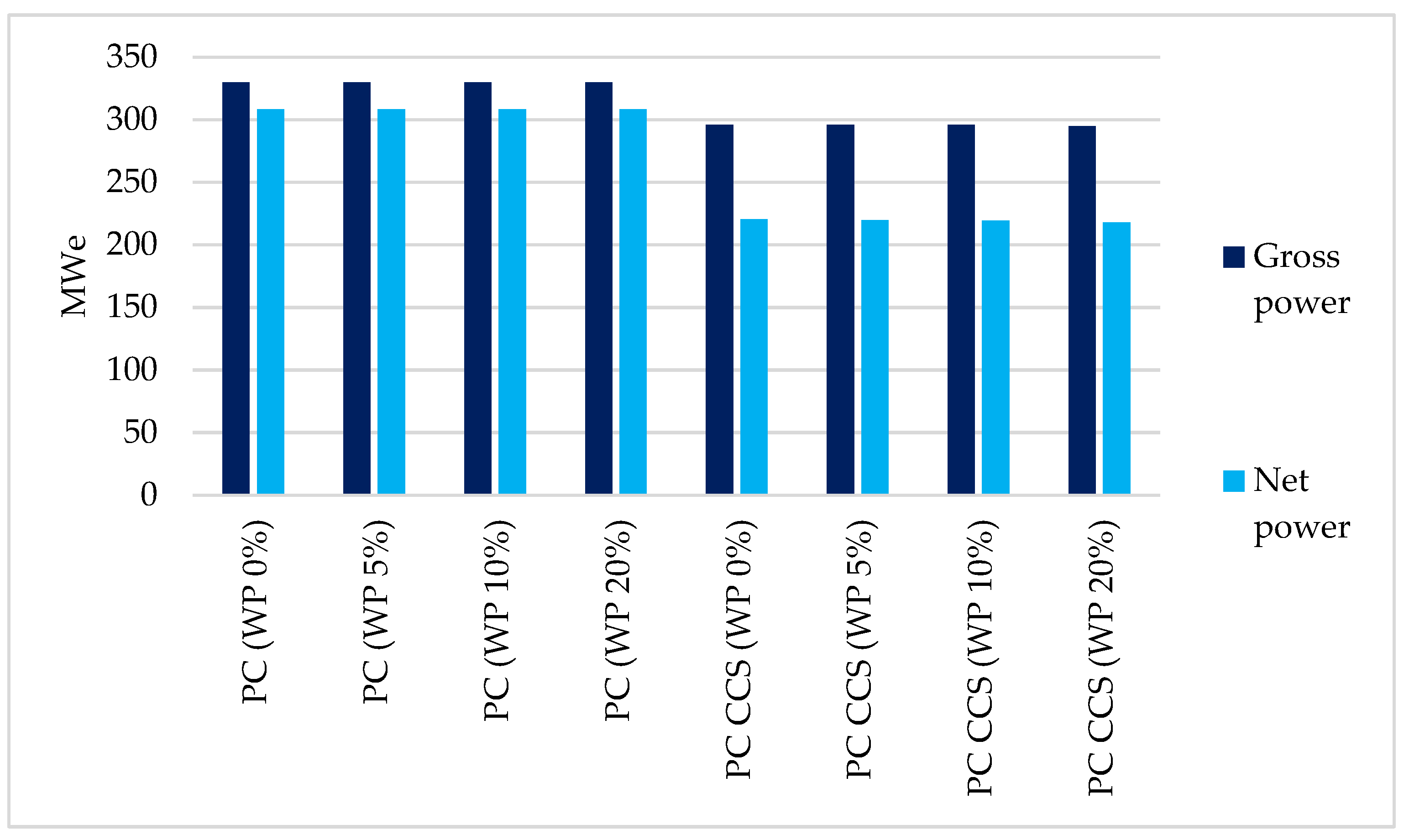




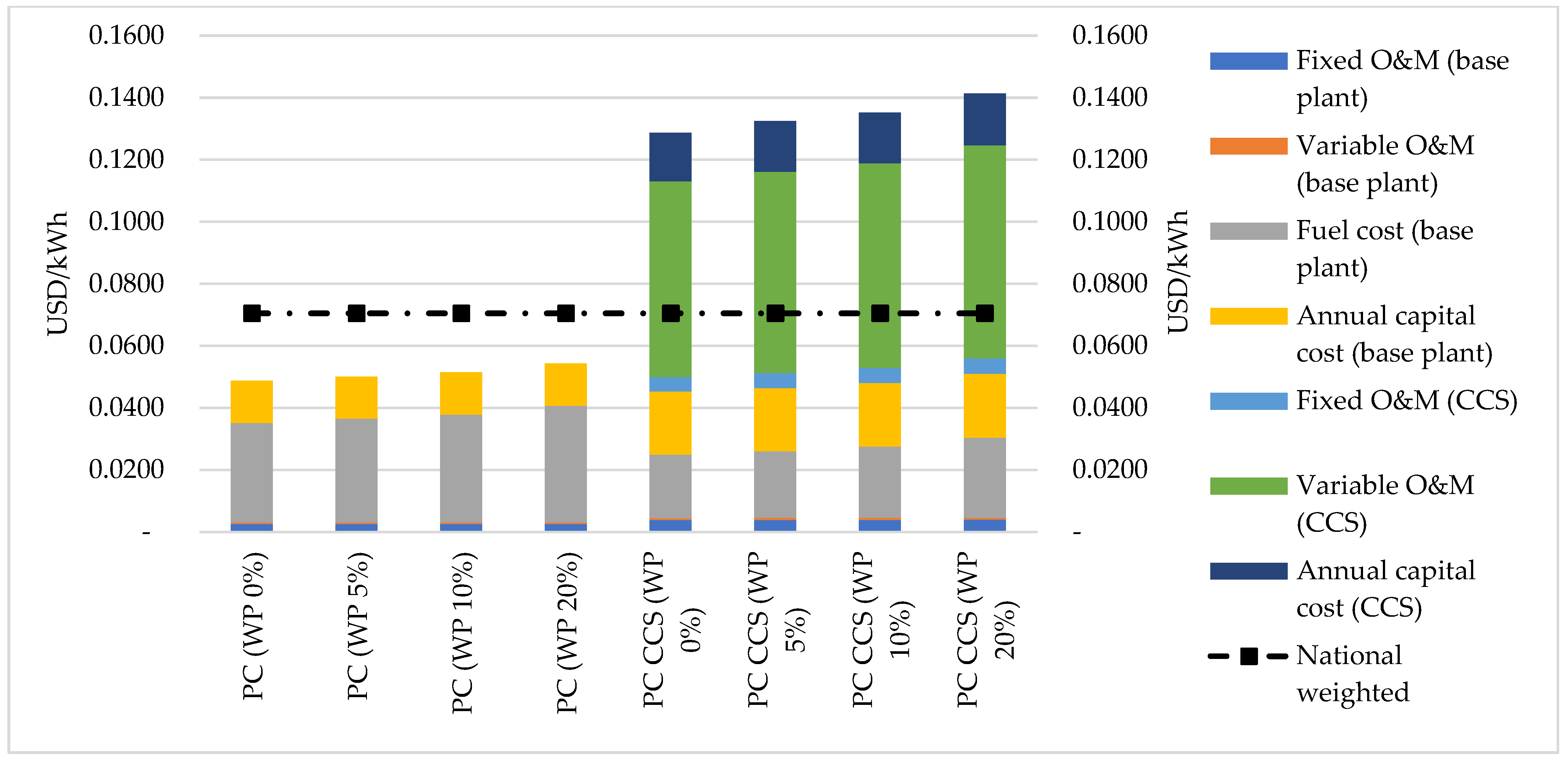

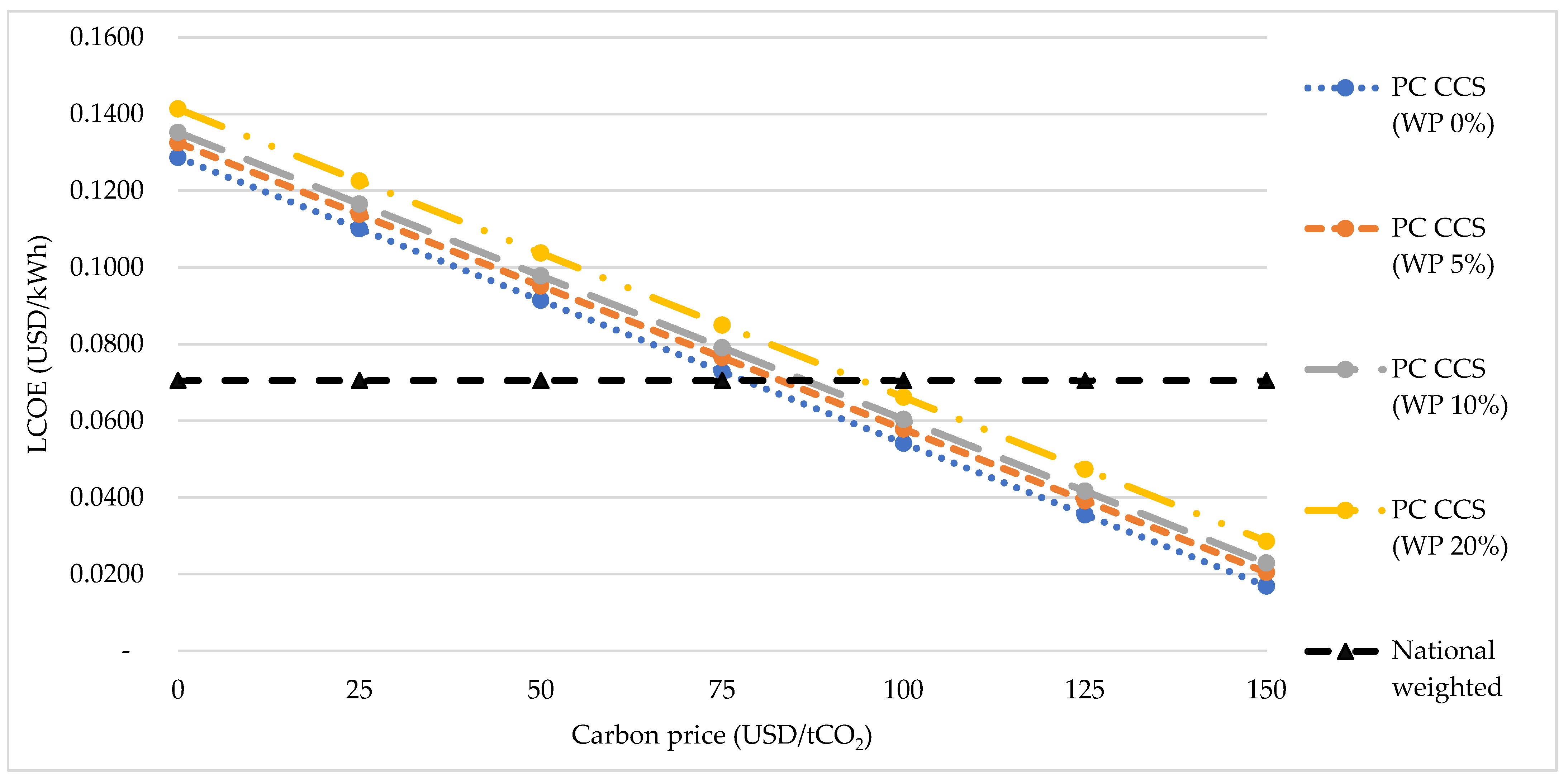
| Parameter | Unit | Value | Refs. |
|---|---|---|---|
| Discount rate | % | 10 | [62,63] |
| Sub-bituminous price (CIF) | USD/ton | 65 | [64] |
| Wood pellet price (CIF) | USD/ton | 115 | [65,66] |
| Effective tax rate | % | 22 | [67] |
| Labor rate 1 | USD/hour | 5 | [68] |
| Number of Operating Shifts | shifts/day | 3 | [54] |
| Currency | - | Constant USD | [54] |
| Year reported | year | 2020 | [54] |
| Ammonia cost 2 | USD/ton | 393 | [69] |
| Amine cost 3 | USD/ton | 1190 | [70] |
| CO2 transportation 4 | USD/ton | 8.1 | [71] |
| CO2 storage 4 | USD/ton | 8.1 | [71] |
| Maximum generating main steam (Constrain) | t/h | 969 | Commissioning test |
| Scenario | Description | Fuel |
|---|---|---|
| PC (WP 0%) | PC (base case) | Sub-bituminous |
| PC (WP 5%) | PC (co-firing 5% wood pellets) | Sub-bituminous + wood pellets |
| PC (WP 10%) | PC (co-firing 10% wood pellets) | Sub-bituminous + wood pellets |
| PC (WP 20%) | PC (co-firing 20% wood pellets) | Sub-bituminous + wood pellets |
| PC CCS (WP 0%) | PC CCS (base case with CCS) | Sub-bituminous |
| PC CCS (WP 5%) | PC CCS (co-firing 5% wood pellets) | Sub-bituminous + wood pellets |
| PC CCS (WP 10%) | PC CCS (co-firing 10% wood pellets) | Sub-bituminous + wood pellets |
| PC CCS (WP 20%) | PC CCS (co-firing 20% wood pellets) | Sub-bituminous + wood pellets |
| Item | Unit | PC CCS (WP 0%) | PC CCS (WP 5%) | PC CCS (WP 10%) | PC CCS (WP 20%) |
|---|---|---|---|---|---|
| Cost of CO2 avoided | USD/t CO2 | 107.281 | 110.346 | 111.799 | 115.697 |
| Cost of CO2 captured by CC | USD/t CO2 | 59.000 | 60.331 | 61.047 | 62.634 |
Disclaimer/Publisher’s Note: The statements, opinions and data contained in all publications are solely those of the individual author(s) and contributor(s) and not of MDPI and/or the editor(s). MDPI and/or the editor(s) disclaim responsibility for any injury to people or property resulting from any ideas, methods, instructions or products referred to in the content. |
© 2024 by the authors. Licensee MDPI, Basel, Switzerland. This article is an open access article distributed under the terms and conditions of the Creative Commons Attribution (CC BY) license (https://creativecommons.org/licenses/by/4.0/).
Share and Cite
Rahmanta, M.A.; Aprilana, A.; Ruly; Cahyo, N.; Hapsari, T.W.D.; Supriyanto, E. Techno-Economic and Environmental Impact of Biomass Co-Firing with Carbon Capture and Storage in Indonesian Power Plants. Sustainability 2024, 16, 3423. https://doi.org/10.3390/su16083423
Rahmanta MA, Aprilana A, Ruly, Cahyo N, Hapsari TWD, Supriyanto E. Techno-Economic and Environmental Impact of Biomass Co-Firing with Carbon Capture and Storage in Indonesian Power Plants. Sustainability. 2024; 16(8):3423. https://doi.org/10.3390/su16083423
Chicago/Turabian StyleRahmanta, Mujammil Asdhiyoga, Almas Aprilana, Ruly, Nur Cahyo, Tiva Winahyu Dwi Hapsari, and Eko Supriyanto. 2024. "Techno-Economic and Environmental Impact of Biomass Co-Firing with Carbon Capture and Storage in Indonesian Power Plants" Sustainability 16, no. 8: 3423. https://doi.org/10.3390/su16083423






